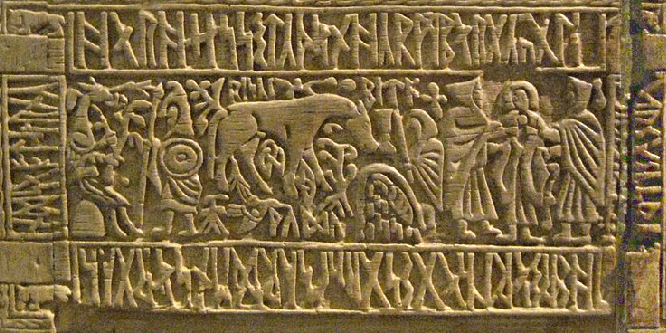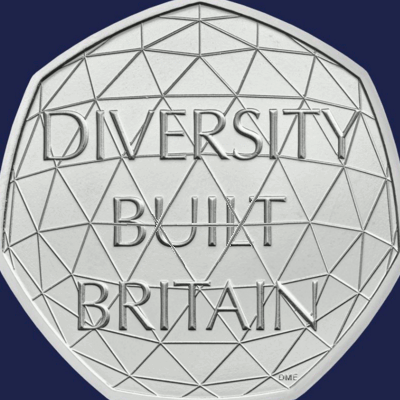2. Who was building Britain's History? Hardly the Hubshees!
Who was building Britain, really? One recent
British coin, now in circulation, claims that diversity did. Right
now diversity seems to mean that some "minority types"
become the darlings of the media and the gentry. Due to the political
correctness rules they even get away with trashy statements easily.
For instance, when it came to the diversity coin, the Indian Rishi
Sunak, in 2020 some kind-of Finance Minister of Britain, was heard
saying:
»I have seen first-hand the contribution made by
ethnic minority communities to Britain’s history. That is why I
backed the “We Too Built Britain” campaign and requested
that the @RoyalMintUK introduced this new coin to celebrate it.«
What strange kind of nonsense, really! Rishi is
rich of course, but rather dark and ugly like other hubshees. He has
a rather slim brow, a feature typically signifying moderate
intelligence only. When he talks about Britain's history that he saw
"first-hand", he can only mean a dozen of years or so, or
maybe the post-war era. Rishi seems to be quite unable to accept and
compute that British history spans over at least the last 10.000
years. Until the most recent era, only the truly British were
building Britain – minorities didn't. Occasionally aliens
migrated or invaded into Britain, but such guys nearly always came
from Europe. Most were so much fellow Europeans that they became
British soon.
That is at least what serious historians and
intellectuals would have to say, when asked to tell the truth about
this. It's not a difficult thing when it comes to the facts of
history. But it's difficult when politics are touched. Mister Suntan
is a valuable member of the Conservatives Party, since even if he
talks nonsense at times he helps them to bring in the votes of the
minority voters. That seems to be rather inevitable in a democracy
that grants the right to vote and rule not only to those who belong
to the demos (Greek: the people) but also to strangers, who
moreless belong to other peoples. And isn't it true that the truly
British talk nonsense too at times? We must nevertheless find it
worrying that the idea of diversity makes it's supporters bring up
such remarkably bad nonsense.
A campaigner of the Glostershire campaign said to
the press, that the coin will »help bridge the nation's past«.
So what is there to bridge? That sounds like the Brits did some
things wrong in the past, when they were building bridges to faraway
colonies to let enter in too many strangers. I assume that Mr. Suntan
was feeling slightly worried, when he said what he said about
Britain's history, like: That can't really be correct. But
maybe he talked down his worries, like politicians often do. The
slogan sounded too good after all to his ears. And isn't such dubious
diversity talk in some way exempt from criticism right now, like a
religious dogma? After all, diversity is even a principle of the
religion of the Old Norsemen, who came to the British Isles with all
the Vikings. Even among the ancient Nordic gods there is a black guy.
It's Surt, the "Swarthy One". His role is to lead refugees
and immigrants in hordes to the North. That is supposed to lead to
the end of the gods and a conflagration. While this ancient Nordic
stuff is mythology only, it should warn us to not underestimate the
power of black magic, that some few guys with black skin and negroid
features may be able to produce. The big problem with this is that
nobody but God understands.
The Universal Truth Religion (UTR) has it that
devilish aliens from outer space interfere into the affairs of our
world. Rotten Greys try to find key persons to manipulate destiny,
and then they try to clutch on them and make them successful and
famous. For this they rely on bad, ruined aliens planets; where
degenerates (wonks) live in religious delusion, misery and pains.
Most alien planets were ruined by a cataclysm, a series of worldwide
super-catastrophes. On most alien planets the populations are also
separated into major and minor races. One major race is assigned to
one continent, and separated into seven or more minor races. Some
planets are only inhabited in a region that we call the Orient. The
races are naturally of better or lesser quality. Dark skin colour
does naturally signify low racial quality. The Greys try to promote
and make popular a few guys with dark skin, since they have more
power over these. A deity of a ruined planet is rather powerless.




 Now
this is the British coin that made me write this text. I must admit
that I especially like British coins since my younger days. When I
was in Britain once, I gathered a large number of old shillings.
These were much less worth than a Deutsche Mark, but they nicely
fitted into Deutsche slot machines. At that time I was an atheist,
and while I didn't believe in any higher powers, I was insensitive
for the bad inspiration that made me carry out such unlawful deeds. I
got caught at once, but a lady only made me change back the coins. I
still was lucky that I didn't become a bad boy early in my life, but
a jurist instead. That may not have happened if I had been really
poor at that time. I guess that also those types with more sympathies
for the diverse varieties of socialism will find it harder to always
be correct. It is also indisputable that people of darker skin colour
are less law-abiding by nature.
Now
this is the British coin that made me write this text. I must admit
that I especially like British coins since my younger days. When I
was in Britain once, I gathered a large number of old shillings.
These were much less worth than a Deutsche Mark, but they nicely
fitted into Deutsche slot machines. At that time I was an atheist,
and while I didn't believe in any higher powers, I was insensitive
for the bad inspiration that made me carry out such unlawful deeds. I
got caught at once, but a lady only made me change back the coins. I
still was lucky that I didn't become a bad boy early in my life, but
a jurist instead. That may not have happened if I had been really
poor at that time. I guess that also those types with more sympathies
for the diverse varieties of socialism will find it harder to always
be correct. It is also indisputable that people of darker skin colour
are less law-abiding by nature.